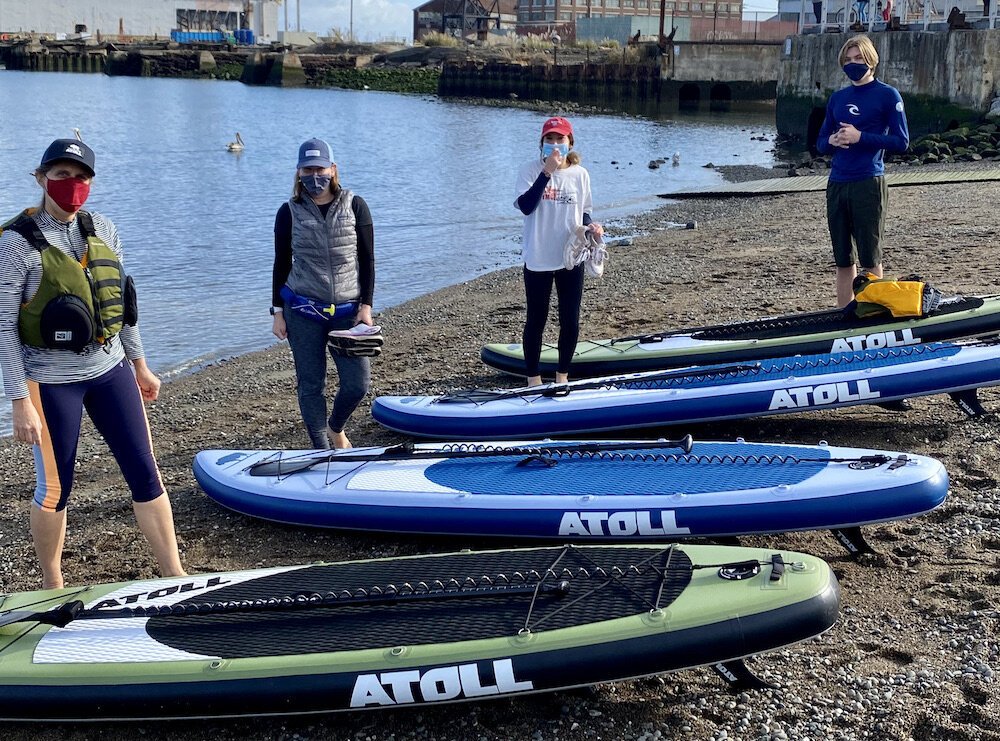What To Wear When You Paddle?
As the club has grown and the San Francisco paddle board summer camps have filled, one of the primary questions I get asked is what to wear on the water. The answer may not be as obvious to some as others. Various factors also contribute to your apparel decisions. So let’s dive into this (pun very much intended).
First you need to frame your activity, location, conditions, weather, and skill level: Are you kayaking or paddle boarding? Will you be on a lake, river, bay, or ocean? Is it hot or cold, choppy or flat, strong current or slack tide? Is this your first time, intermediate or experienced? Once you compartmentalize these factors, it will become easier to plan.
There is also a comfort component to consider. Paddling is a repetitive motion activity. You’ll want to minimize the restriction of motion in your arms. This is why PFD vests, belts and shorty wet suits are preferred. If you’re experienced and want the most range of motion, you’ll want to consider clothing that doesn’t restrict.
Dogpatch Paddlers on a Mild SF Winter Day
Life Vests & Dry Bags
Regardless of your clothing choice, we adamantly insist that everyone have some sort of personal floatation device (PFD). The coast guard requires them and it’s just good sense. To that, you can decide between a vest and a belt based upon your comfort level. Belts have no immediate effect and only provide support if you pull a handle to activate the compressed air to inflate (much like an airplane PFD). Generally, I would suggest a vest unless you are experienced and confident that you won’t need the instant and extra floatation support if you find yourself in the water.
We also strongly recommend bringing dry bags to protect your phone, dry clothes, water bottle, snacks, etc. You can stow them in the hull of most kayaks and clip them to bungees or d-rings on paddle boards.
Kayaking
The main difference between paddle boarding and kayaking for apparel is your position on your craft and the potential for water exposure. Kayaking is seated with the hull of the boat cutting through the water. There is very little chance that you will capsize and fall in, so a wetsuit is not much of a factor for yard-sale swimming (unless you are on a sit-on-top kayak that has less protection). That said, depending on your boat, you’re likely to take in some water and you will be sitting in it while paddling, sometimes hours at a time. If the temperature is cold, waterproof pants or dry pants may be a good solution. If you’re prone to the cold you might consider a wet suit. In warm weather, you may not care as much and be fine with board shorts.
You’ll want to consider the chop factor: because you are low to the water, in rough conditions, kayakers will experience spray and possibly waves crashing your gunwale. Your upper body is much more exposed and therefore you may want to consider full-body gear in these conditions. In the ocean, on a swift river, or on a day in the Bay where the current is strong and the wind is kicking, a wet or dry suit might be the best call.
Experience is less of a factor in selecting kayaking outfits. For the most part, you’re not at significant risk of capsizing unless you’re in rough conditions (which newbies should probably avoid). So, generally speaking, these suggestions apply to most.
Paddle Boarding
It’s called “stand up paddle boarding” for a reason. Under optimal conditions, you’re going to be on your feet, ideally away from the water. That said, there are a number of conditions that may force you to your knees or even in the prone position. Paddle boarders are also forced to deal with balance issues that make it much more likely to fall in the water. Because of these factors, planning is a little more complicated.
Under the most ideal circumstances: sunny day, flat water, moderately experienced paddlers don’t need much. Board shorts, T-Shirt, flip-flops, and PFD. When I take groups out for paddle board lessons, I teach them how to use their core and paddle properly. If you practice the technique, you’re not likely to fall in at all. Still, an errant wake, strange eddy, or just losing your focus can easily lead to a spill. Even the most advanced paddlers get unbalanced at times.
So, for those factors, you might consider a wet suit if you are paddling in cold water, are new to the sport, prone to imbalance, just hate the cold water or have tide / chop conditions that are likely to challenge the balance of any paddler.
On colder days, I use a long sleeve water-wicking shirt and similar long pants. I find the warm is enough relative to the activity level. I also enjoy the free range of motion. That said, less experienced paddlers may opt for a thin wet suit (2-3mm) on colder / choppy days.
Dogpatch Paddle Campers on a Sunny Day!
Kids & Paddle Summer Camps
The primary factors for outfitting kids to paddle is how much time they will spend in the water. Unlink most adults, kids seem to be more content falling or even jumping in the water. So, we’re more inclined to recommend wet suits, especially on colder or overcast days. You might consider a shorty suit for your 8-12 year olds. The range of motion will be welcomed, plus there is extra buoyancy to bolster the PFD. But generally speaking, most kids are ok in a bathing suit, board shorts and a PFD vest.
Summary


